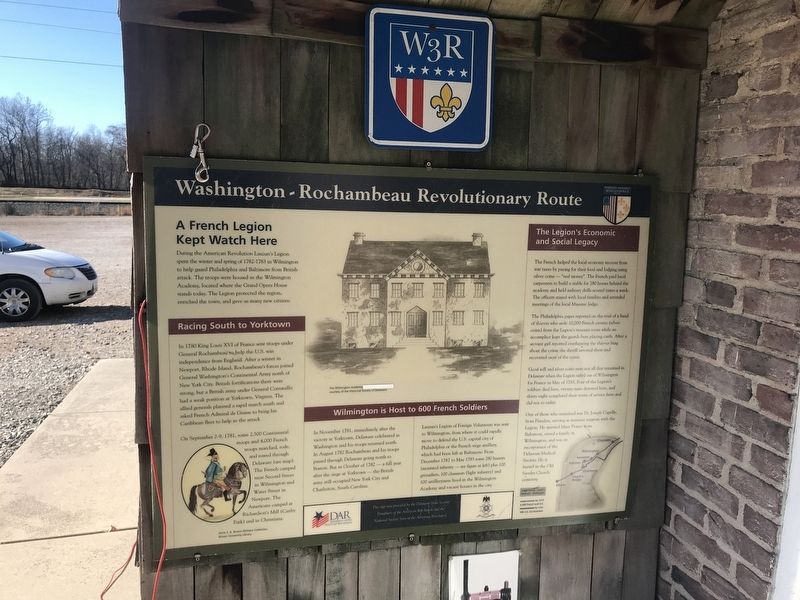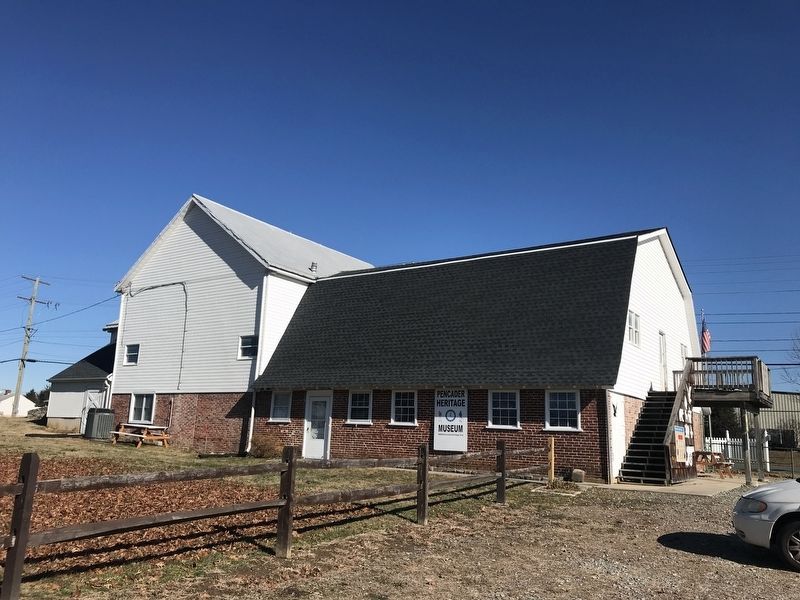Newark in New Castle County, Delaware — The American Northeast (Mid-Atlantic)
Washington-Rochambeau Revolutionary Route
A French Legion Kept Watch Here
During the American Revolution Lauzun's Legion spent the winter and spring of 1782-1783 in Wilmington to help guard Philadelphia and Baltimore from British attack. The troops were housed in the Wilmington Academy, located where the Grand Opera House stands today. The Legion protected the region, enriched the town, and gave us many new citizens.
Racing South to Yorktown
In 1780 King Louis XVI of France sent troops under General Rochambeau to help the U.S. win independence from England. After a winter in Newport, Rhode Island, Rochambeau's forces joined General Washington's Continental Army north of New York City. British fortifications there were strong, but a British army under General Cornwallis had a weak position at Yorktown, Virginia. The allied generals planned a rapid march south and asked French Admiral de Grasse to bring his Caribbean fleet to help in the attack.
On September 2-9, 1781, some 2,500 Continental troops and 4,000 French troops marched, rode, and rowed through Delaware (see map). The French camped near Second Street in Wilmington and Water Street in Newport. The Americans camped at Richardson's Mill (Canby Park) and in Christiana.
Wilmington is Host to 600 French Soldiers
In November 1781, immediately after the victory at Yorktown, Delaware celebrated as Washington and his troops returned north. In August 1782 Rochambeau and his troops passed through Delaware going north to Boston. But in October 1782 - a full year after the siege at Yorktown - the British army still occupied New York City and Charleston, South Carolina.
Lauzun's Legion of Foreign Volunteers was sent to Wilmington, from where it could rapidly move to defend the U.S. capital city of Philadelphia or the French siege artillery, which had been left at Baltimore. From 1782 to May 1783 some 280 hussars (mounted infantry - see figure at left) plus 100 grenadiers, 100 chasseurs (light infantry) and 100 artillerymen lived in Wilmington Academy and vacant houses in the city.
The Legion's Economic and Social Legacy
The French helped the local economy recover from war taxes by paying for their food and lodging using silver coins - "real money". The French paid local carpenters to build a stable for 280 horses behind the academy and held military drills several times a week. The officers stayed with local families and attended meetings of the local Masonic lodge.
The Philadelphia paper reported on the trial of a band of thieves who stole 10,000 French crowns (silver coins) from the Legion's treasure room while an accomplice kept the guards busy playing cards. After a servant girl reported overhearing the thieves brag about the
crime the sheriff arrested them and recovered most of the coins.
Good will and silver coins were not all that remained in Delaware when the Legion sailed out of Wilmington for France in May 1783. Four of the Legion's soldiers died here, twenty-nine deserted here, and thirty-eight completed their terms of service here and did not re-enlist.
One of those who remained was Dr. Joseph Capelle, from Flanders, serving as assistant surgeon with the Legion. He married Mary Pearce from Baltimore, raised a family in Wilmington, and was an incorporator of the Delaware Medical Society. he is buried in Old Swedes Church cemetery.
Erected by Daughters of the American Revolution.
Topics and series. This historical marker is listed in this topic list: War, US Revolutionary. In addition, it is included in the Daughters of the American Revolution, and the The Washington-Rochambeau Route series lists. A significant historical month for this entry is May 1783.
Location. Marker has been permanently removed. It was located near 39° 38.383′ N, 75° 43.778′ W. Marker was in Newark, Delaware, in New Castle County. Marker was on Sunset Lake Road (Delaware Route 72) north of Dayett Mill Road, on the left when traveling north. Located on south side of Pencader Heritage Museum. Touch for map. Marker was at or near this postal address: 2029 Sunset Lake Rd, Newark DE 19702, United States of America.
We have been informed that this sign or monument is no longer there and will not be replaced. This page is an archival view of what was.
Other nearby markers. At least 8 other markers are within walking distance of this location. Delaware Militia (within shouting distance of this marker); a different marker also named Washington-Rochambeau Revolutionary Route (within shouting distance of this marker); The Royal Deux-Ponts Memorial (within shouting distance of this marker); The Battle of Cooch's Bridge (within shouting distance of this marker); French General Comte de Rochambeau and the French Army Memorial (within shouting distance of this marker); Hessian Soldiers Memorial (within shouting distance of this marker); Germans & German-Americans in The American War of Independence (within shouting distance of this marker); Marquis de Lafayette (within shouting distance of this marker). Touch for a list and map of all markers in Newark.
Credits. This page was last revised on December 31, 2023. It was originally submitted on January 22, 2022, by Adam Margolis of Mission Viejo, California. This page has been viewed 200 times since then and 11 times this year. Last updated on November 3, 2022, by Carl Gordon Moore Jr. of North East, Maryland. Photos: 1, 2. submitted on January 22, 2022, by Adam Margolis of Mission Viejo, California. • Devry Becker Jones was the editor who published this page.

